High demand and low supply of tech talents continue to create pressure on technological businesses.
According to Code.org, there is a serious shortfall of IT specialists in the USA. It reports over 458,000 open jobs across the US. The number of fresh graduates with a degree in Computer Science hovers around 91,000—not even 20% of demand.
The current market state pushes business owners to look for effective ways to attract and engage talents. Team augmentation can help.
Read out the benefits, limitations, and best-case scenarios of IT staff augmentation and compare it to traditional in-house hiring.
1
What Is In-House Recruitment? How Does it Work?
In-house recruitment means finding candidates for job openings using a company’s internal resources.
In-house recruiters are responsible for sourcing, screening, and communicating with candidates to the in-house development team. Typical duties include:
- collecting requirements
- writing and updating job descriptions
- sourcing candidates
- conducting screening calls
- scheduling interviews
- and more
Company recruiters usually focus on long-term growth. They look for the best fit for expertise, commitment, and shared views of development processes.
The problem here lies in the myriad challenges of tech recruitment. Recruiters must be exceptionally good at searching for and filtering relevant tech talents. Due to dire skill shortage, each required position takes recruiters at least 36 to 42 days to fill. Recruiters need even a greater amount of time when searching for hard-to-find niche experts, e.g., DevOps engineers.
There are also related expenses on the list. It is necessary to keep employee management costs in mind, such as HR activities, taxes, benefits and compensations, insurances, office rent, equipment, and more.
So it makes fiscal and time sense for businesses to turn to staff augmentation when emergencies arise.
2
What Is Staff Augmentation and How Does it Work?
IT staff augmentation means adding one or several temporary outside developers to your development team—either employees of a specialized service provider or independent contractors. A company might chose to engage a dedicated team when there is a large scope under a tight time constraint.
According to the Deloitte Global outsourcing survey 2022, 57% of executives rely on staff augmentation to ensure cost-effective software development and maintenance.
Developers report directly to the client’s project manager. Vendors take on selection and matching:
- Receive a request describing needs and aims.
- Select candidates from the internal pool or search in the local market.
- Present candidates to the client. Schedule interviews with selected engineers.
- Receive approvals of candidates. Finalize cooperation details.
- Coordinate onboarding.
Vendors lift many responsibilities off their clients’ shoulders. They save time and resources needed for:
- HR activities
- workplace
- hardware and software
- insurance and medical leaves
- etc.
3
Differences between Staff Augmentation and In-House Hiring
In-house hiring is an expensive long-term investment. It enables companies to build a culture and increase employees’ commitment to business goals.
However, barriers are high. 46% of HR leaders pinpoint high attrition of in-demand talents as one of the biggest challenges throughout 2023. This creates unprecedented pressure on company resources, according to a Gartner survey.
For its part, staff augmentation helps companies balance scope and workload while saving costs without impacting morale of the core team. Companies avoid hassles linked to full-time employment when an expert is needed for a limited time. Flexibility increases. There is no need for a layoff caused by changes in project scope.

PROS AND CONS OF STAFF AUGMENTATION
The staff augmentation model saves time and money. It ensures scalability and flexibility. Companies decrease time by adding engineers with the same working culture and mind stack.
However, it could have a negative impact when company processes are unprepared to efficiently manage an external workforce.
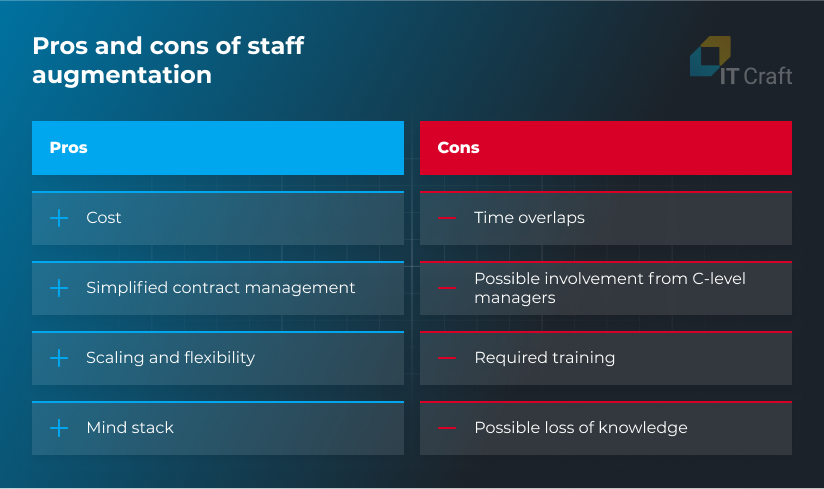
Pros of staff augmentation model:
Working with Central and Eastern European companies, you get lower hourly rates for engineers at the same expertise level compared to Western Europe and North America regions. Also, recruitment costs are handled by the vendor. Companies keep within both budget limits on hiring and project development.
Choosing IT Craft services, clients save up to 50% of their allocated IT budget.
- Pro two. No HR and recruitment fees
Staff augmentation has little-to-no impact on client’s HR & recruitment department’s workload. Companies receive CVs of vetted candidates from the vendor’s pool, saving them the headaches of screening and sourcing. The vendor’s HR department is responsible for management of augmented labor. The client HR focuses solely on in-house team retention—a win-win.
- Pro three. Scaling and flexibility
Staff augmentation simplifies access to the talent pool of sought-after skills and expertise. 42% CTOs consider outsourcing as the key to successful scaling. They can quickly schedule interviews, engage, and onboard rare experts when there are none available for immediate hire in their location.
Staff augmentation is fast—faster than in-house hiring due to selection from candidates who are ready to take up their duties as soon as required. Negotiation time is also shorter. For instance, it takes from three days for IT Craft to select the right candidates and send their CVs to you and from two weeks to complete a vacant position but faster than an internal department.
Dependable vendors rely on the same or similar working culture. In particular, IT Craft engineers share the same business values and goal-oriented approach. This helps simplify integration into the client team. Our engineers harmonize efforts with the in-house team. Onboarding time decreases.
Cons of IT staff augmentation:
Time differences might be an issue when remote engineers live far from the client. Workflow adjustment becomes critical, ensuring everyone is available for at least a few hours a day. Hence, the team must synchronize schedules and coordinate efforts for the project pace.
- Con two. Possible involvement from C-level managers
Indirect costs increase when engaging a less experienced vendor. A lot of time might be required to align and manage a team. Such management efforts on the client side often involve C-level specialists whose time is expensive. Any potential cost savings are lost when this happens.
- Con three. Required training
Staff augmentation might not work for niche companies where preliminary training is key. Long onboarding makes staff augmentation less beneficial than in-house hiring or internal training. Yet, when both options are unavailable, it makes sense to consider long-term staff augmentation to level costs.
- Con four. Possible loss of knowledge
Documenting is an important part of the development process. Finding a reliable vendor that adheres to high-quality work standards and updates project documentation/knowledge base is critical. Without ensured knowledge transfer, businesses face a loss of control over internal processes and slip into vendor dependency.
PROS & CONS OF IN-HOUSE HIRING

Businesses benefit from the following pros:
It is simpler to build a working culture that all team members accept and share. Full-time employees show high motivation when they feel an affinity for a company’s brand. It is easier for the company’s HR department to organize non-working activities and facilitate team building when everyone is onsite.
Personal communication enables teams to solve problems fast. Even if some employees work remotely, they can show up at the office when an issue emerges. They can find the responsible person and discuss an issue face-to-face. Skill transfer is also straightforward if someone leaves.
- Pro three. Planning and execution
It is much easier to plan when the team is available during the same business hours. Developers can easily synchronize their schedules and remain in instant touch. They can quickly address any urgent problem, e.g., getting emergency support calls. Reliability increases.
- Pro four. Security and quality control
Organizing and maintaining internal security standards is easier when the entire team works from the same office. The project manager has the most comprehensive project control. Working on the project in-house enables them to monitor all project steps and conduct regular quality checks.
The in-house hiring strategy has the following cons:
Both initial and long-term investments are high. On average, costs that companies spend to fill in a position equal to 6- to 9-month salary. A single senior developer generates $74,600 and $111,950 in costs until they get up to speed, based on the average software engineer salary, according to Glassdoor.
According to a LinkedIn survey, software development has one of the highest staff turnover rates at 13.2%. Over 50% of software engineers stay at a company for about two years before changing employers or pursuing a freelancing career.
- Con three. Operational costs
Operational costs are high. Apart from adding 30% – 50% in benefits and taxes or $44,850 – $74,750, companies must offer developers the best working environments to facilitate maximum production output. Businesses must invest in HR processes to prevent burnout or dissatisfaction.
- Con four. Limited skill development
Internal training opportunities are also limited. In-house employees have little-to-no interest in training new competencies. Instead, they want to excel at already-acquired skills and actively seek opportunities outside rather than gain new competencies. 40% of employees resign due to a lack of opportunities for career development.
Are looking for excellent temporary professions?
We are here to help you to fill skill gaps efficiently.
Contact Us
4
IT Staff Augmentation vs. In-House: What Should You Choose?
According to a survey conducted by Staffing Industry Analysts, 64% of companies across North America and the EU use staff augmentation services to enhance their IT processes.
In-house is a better fit for an established company with a growing budget for staff management:
- Your company has already established HR processes and internal culture.
- You can quickly expand the hiring budget.
- There is strong emphasis on keeping strict control over internal processes.
- Reaction to team member requests is critical.
Staff augmentation works better when:
- You are a startup or an SMB looking for a time-sensitive, cost-savvy solution.
- You need an urgent replacement or a rare specialization. Both are hard to find in the market.
- You seek improved workload distribution.
- You benefit from simplified employee management when the vendor handles legal support, taxes, benefits, payrolls, etc.
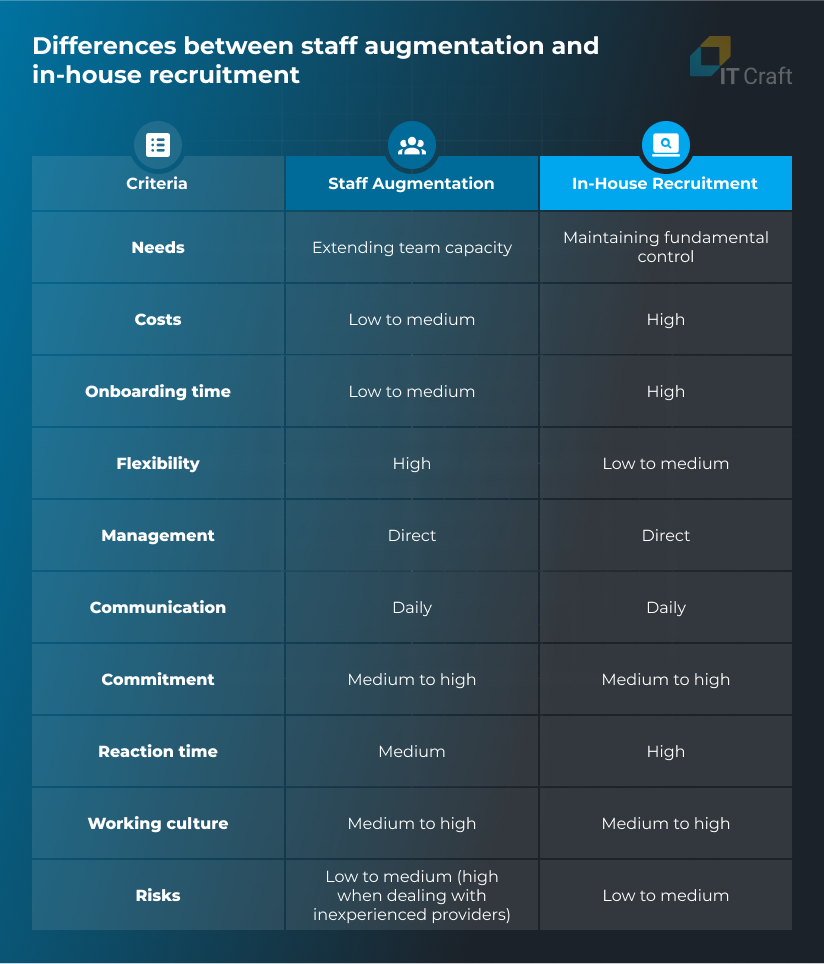
5
Companies Using Staff Augmentation
Any company can use staff augmentation services.
Companies that have already hired and managed one or several remote developers are more comfortable with augmentation. Still, it is possible without prior experience too.
Several of many well-known examples of when remote workers helped startups build and expand software products:
- InVision – online productivity platform.
- Skyscanner – flight travel planner.
- Skype – VoIP solution and text messenger.
- Slack – corporate messenger and productivity platform.
- Wise – devise exchange and money transferring service.
Enterprises make extensive use and benefit from staff augmentation:
- Google – Fills in temporary roles using the staff augmentation model, including software development, design, and data analysis. External specialists work temporarily. Staff augmentation allows Google to access top expertise without investing in hiring and training activities.
- Amazon – Regularly contracts temporary and long-term specialists from different vendors to keep up with gradual workload growth and its spikes, e.g., in cloud management. The company acquires an engaged vendor when such expertise becomes crucial.
- IBM – Augments teams with external tech talents when enhancing certain projects or initiatives in software development, IT infrastructure management, or Big Data projects. Team augmentation enables the company to flexibly balance its workforce.
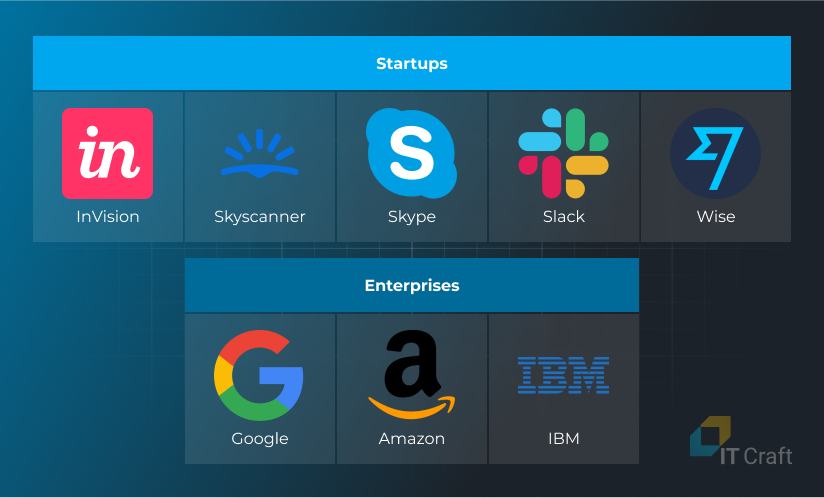
6
IT Craft Expertise
IT Craft has been a reliable partner on projects of varying size and complexity.
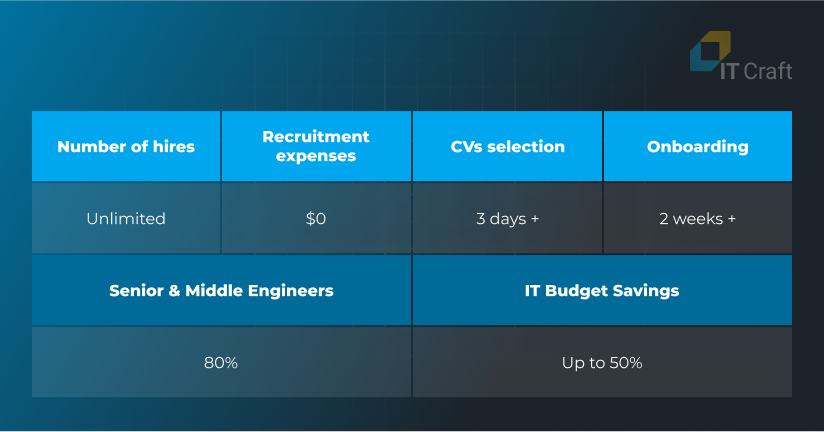
Here are two examples of keeping client projects up and running:
Adorama
One of the biggest media retailers worldwide.
Years of cooperation: 2007 – 2019
Technology: .NET | C# | MS SQL | JQuery
Challenge: The client had an ecommerce platform maintained by a miniscule in-house team. The team required help to support six retail businesses with growing digital needs.
Solution: IT Craft engineers successfully completed a small test task. The cooperation grew fast while the IT Craft team took over platform development, testing, and maintenance, helping the in-house team implement strict business requirements on time and within budget.
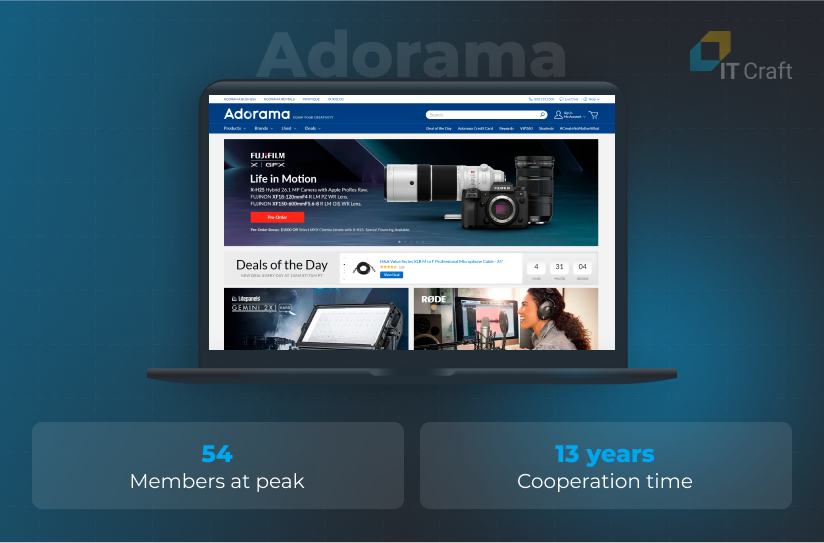
!
Summary
In-house hiring makes sense when your company can allocate a high hiring budget and increase it when competition steepens.
Choose staff augmentation as a reasonable alternative, enabling to close skill gaps with minimum hassles—this is what 64% of companies do to meet their goals.
If you are looking for a dependable vendor experienced and efficient in finding excellent temporary professions to fill skill gaps efficiently, we are here to help.









